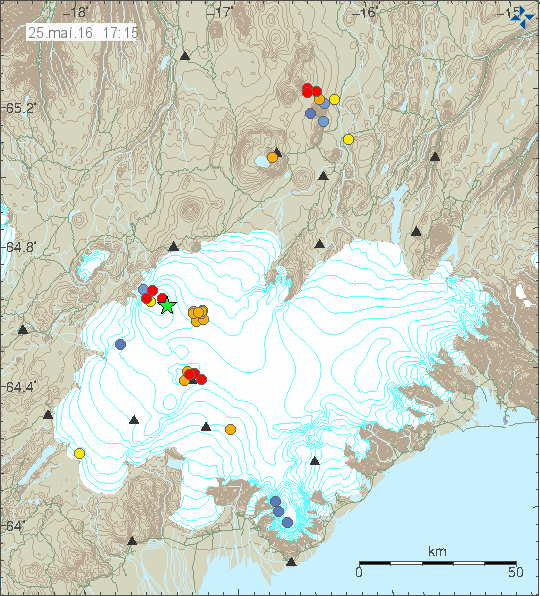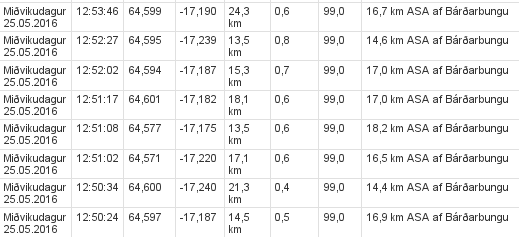This the first analyse article that I’m going to write. It is going to a short one and not written over few days, as is the plan to have them in the future. The reason for this is that this information might get outdated quickly as things change in Bárðarbunga volcano. This is going to be broken down into few parts for clarity (if possible).
Current activity in Bárðarbunga volcano
Bárðarbunga volcano is preparing for a new eruption and has been doing so since March-2015, few days after the eruption ended in Holuhraun. Where this eruption is going to take place is impossible to know fore sure, but there are clues to what might happen (it doesn’t mean it is going to). Current earthquake activity pattern suggests that the next eruption is going to take place directly south of Bárðarbunga volcano, slightly south of the Holuhraun dyke formation. At that location there is a dyke formation that has been building up for the last few years and in recent months I’ve noticed a slight increase in activity around that dyke, it has been making branches from it self, creating small earthquakes swarms in the process. I don’t know how large this dyke is, but what is clear from earthquake data is that it is deep, goes down to at least 25 km depth, maybe deeper.

The cluster of orange dots is the dyke showing it self earlier today. Copyright of this image belongs to Iceland Met Office.
Since the activity started in Bárðarbunga volcano, this dyke has changed and appears to have started growing at some point (I don’t know when). Current size suggest that it is already large and contains large amount of magma. Amount is hard to estimate, but pure guess (short of educated) suggests that the amount of magma in this one dyke is already high and more might be at depth (25+ km depth). This one dyke has existed, or formed around 2005 – 2008 at earliest, it might have formed a good while ago, but this are the years I first saw it in the earthquake data. It is all over thick glacier (200 meters or more), so any eruption at that location would result in a glacier flood.
Eruptions risk at the moment
Currently Bárðarbunga volcano is in what I call “Active phase – not erupting”, meaning the volcano is not dormant (no activity at all). The risk of an eruption at the moment is in my view around moderate, nothing suggest that it is at high levels. That however is changing with each passing day and it is my view that one day there is going to be a earthquake swarm and activity that is going to start a new eruption in Bárðarbunga volcano and there is a good chance that eruption is going to take place under the glacier.
The caldera cauldrons (on the rim)
When the earthquake activity, connected with the dyke intrusion started in August-2014 and few eruptions under the glacier, few cauldrons formed in the glacier. Over the past few months those cauldrons have been getting larger and deeper, the glacier they are melting is up to 200 meters thick in this area (far as I know). The reason for this cauldron formation is the collapse (called slow collapse) of the Bárðarbunga volcano in 2014 – 2015 eruption. This suggests that magma has found a pathway to the shallow crust (5> km), but does not have the energy to start an eruption at the moment. This magma might never erupt at all, it might only create new hydrothermal areas in Bárðarbunga volcano. Paper on the collapse of Bárðarbunga volcano caldera can be found here, I don’t know how accurate or if this has been peer-reviewed article.
Earthquake depths
When something happens in Bárðarbunga volcano, like a strong earthquake swarm with magnitude 3,0 or larger earthquake taking place it sometimes has a activity taking place several hours before it. Here is how to spot it if it happens, it does not always take place for random reasons.
![]()
Small earthquake in Bárðarbunga volcano, but notice the depth of 26,8 km. Screen-shot from Iceland Met Office website.
Depth is an important factor here, this earthquake took place at 26,8 km depth, suggesting that magma created it. That is not always the case, but it appears that this time it was. Since 12 hours later a magnitude 3,4 earthquake took place, meaning the pressure inside Bárðarbunga volcano changed (as I understand how this works).

The dyke earthquake swarm. All magnitudes are small, but depth is the interesting part. Screen-shot from Iceland Met Office website.
The dyke earthquake swarm has different pattern. As the magma pushes up the dyke from deep it creates earthquakes along the weak points in its structure, making the depth appear at random as earthquakes are formed. This also expands the dyke a little, low amount of earthquakes indicates that there is not much of a resistance in the dyke where it is expanding at the moment.
Donations
Please remember to support my work so I don’t have to worry about bills and other money connected issues so much. Thanks for the support. 🙂

Wasn’t there the same pattern of deep ones where that cluster is ESE of Bardar before the 2014 eruption, even maybe before Bardar itself really started getting active with quakes? I can check.
It’s an interesting development in this lead up to the next action around there. IMHO, the dyke up towards Holuhruan, and even beyond towards Askja, may open as the pressure builds. On the other hand, the caldera and rim area is weaker than pre 2014 action, so that is more vulnerable this time. I’d go for one of those two eventualities rather than a subglacial eruption on the dyke where that cluster is, ESE, currently.
Thanks Jon great article, Chris would the 2014-15 dyke intrusion not have created a more solid plug than the area around the current dyke? Since the current area has been showing that the stress is causing fractures ( the current series of Quakes in that area ) I think Jon has a stronger case for the current dyke or the rim IMHO.
One of my thoughts there was that the “current dyke” looks to be the same as the beginnings of the 2014 dyke. I’m not sure it follows that because there was an intrusion in an area that the area is more solid. Even if the magma in there has thoroughly cooled and glued it like superglue, it is still likely to be a point of weakness from forces below and around it that are likely to be similar or almost identical to what was there in 2014.
Just suggesting another perspective, we watch and learn 🙂
Good article, but a small correction: Bardarbunga did not actually began preparing for a new eruption until September, when the seismic and GPS data patterns shifted from normal post-eruptive activity into more “pre-eruptive” looking patterns. Even the IMO has confirmed the change of activity type around mid-September, so that is kinda when Bardarbunga system actually began doing something else, which we currently understand as building to a new eruption.
http://s33.postimg.org/rek4fy7hq/KISA_08.jpg
http://s33.postimg.org/bv065hx7z/bb_lib_mag_1.png
Bárðarbunga volcano has a one or more deep magma chamber. It also has a number of shallow magma chambers. It seems that the magma system started recharging (in my view) right after the eruption ended, but at depth, once that change reached the shallower magma chambers, effects started to be seen on the surface.
You can find details on Bárðarbunga volcano here (from Icelandic Met Office), http://en.vedur.is/media/jar/Bardarbunga_kafli20140825.pdf
Is it a bold statement to suggest that the whole area from Grimsvötn to Herdubreid has become more vulnerable due to the stresses of the doming and dike intrusion (conseq. subsidence of the dome) that took place in 2014/15 and that therefore the possible site of a future eruption has become even more unpredictable? Simply because of the increase of weak spots in the crust like Chris W said.
I think that’s fair to say, though not so much down towards Grimsvötn. There wasn’t that much action in 2014 that way. Grims has an independent system to a degree, which appears to be a fair way from going off – 12-36 months? Having said that, we have never seen how action in the Bardar system effects the rhythms of Grims (Grythms? 😉 ).
A lot of deep small quakes in Vatnajokull glacier in several points and in diferent volcanos… i don’t remember to see this earlier… http://en.vedur.is/earthquakes-and-volcanism/earthquakes/vatnajokull/#view=table
Thursday
26.05.2016 15:17:45 64.647 -17.378 1.1 km 3.3 99.0 7.2 km E of Bárðarbunga
followed by :
Thursday 26.05.2016 03:42:28 PM 64.65 -17.449 5.1 km 0.5 99 3.9 km ENE of Bárðarbunga
Thursday 26.05.2016 03:28:52 PM 64.631 -17.492 5.0 km 0.2 99 2.0 km ESE of Bárðarbunga
Thursday 26.05.2016 03:19:32 PM 64.668 -17.514 18.3 km 0.7 99 3.2 km NNE of Bárðarbunga
This look like the start of some swarm activity?
It seems to my uneducated mind that the influx of magma ,that led to the Holuhraun eruption,energized long existing magma emplacements in the caldera,in the vicinity of the rim.When the pressure of that influx reduced in the deep magma reservoir of Bardarbunga due to the eruption,the seismic crisis resolved and now this has been renewed by a fresh smaller influx into a energized shallow system.?Even though this is Iceland,is the caldera showing similarities in its shallow systems to that of calderas in subduction zones,where more evolved magma is involved ,causing seismic events and geothermal activity.
The magma that erupted in Holuhraun had been building up since ~1970 (~44 years) until the eruption in 2014 started.
What is added to all this is the rifting event taking place at this location at the moment. This tectonic plate rifting complicates matters and allows for faster magma movement at depth and shallow crust levels.
https://4.bp.blogspot.com/-_XnREOFRjWQ/VxUAQzloNpI/AAAAAAAAnQM/uBpqSLVAqigOQMRi4qXGgXs5bt33TUO9QCLcB/s280/PicsArt_04-18-02.50.51.jpg
This is the next system of rifting?
Seems like there are 2 energized shallow emplacements on the NE rim,seems to show on the plots of the overall earthquake activity as 2 definite clusters of seismic activityand maybe this is now starting to mobilize the ring fault elsewhere ,due to this elongation effect being exerted North/South?http://www.volcanocafe.org/the-dancing-earth-continental-drift/comment-page-2/#comment-7554